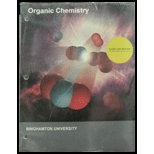
Concept explainers
Interpretation:
The structures for the compounds A and B that are produced in the photochemical chlorination of the given alkane are to be deduced and the factors that influencing their distribution are to be discussed.
Concept introduction:
If the hydrogens in
Among alkanes, tertiary hydrogens are replaced faster than secondary, and secondary faster than primary.
The ratio of the monochlorination products depends on the type of hydrogen that is abstracted by the chlorine atom and the free radical that is formed.
In
Want to see the full answer?
Check out a sample textbook solution
Chapter 10 Solutions
Organic Chemistry (Binghampton University)
- Why does CH 2 CHCHBrCH 3 undergo solvolysis much more rapidly than 2-bromobutane?arrow_forwardAcid-catalyzed dehydration of neopentyl alcohol, (CH3)3CCH2OH, yields 2-methyl-2- butene as the major product. Outline a mechanism showing all steps in its formation.arrow_forwardOn acid-catalyzed dehydration, 1-butanol (CH3CH2CH2CH2OH) can be converted to 1-butene. Write out an equation for the reaction Assign each the appropriate symbol for the mechanism of the reaction (E1 or E2) Draw a suitable mechanism for the reactionarrow_forward
- This problem is adapted from an experiment designed for undergraduate organic chemistry laboratories. (a) Reaction of (E)-1-(p-methoxyphenyl)propene with m-chloroperoxybenzoic acid converted the alkene to its corresponding epoxide. Give the structure, including stereochemistry, of this epoxide.(b) Assign the signals in the 1H NMR spectrum of the epoxide to the appropriate hydrogens. δ 1.4 (doublet, 3H) δ 3.8 (singlet, 3H) δ 3.0 (quartet of doublets, 1H) δ 6.9 (doublet, 2H) δ 3.5 (doublet, 1H) δ 7.2 (doublet, 2H) (c) Three signals appear in the range δ 55–60 in the 13C NMR spectrum of the epoxide. To which carbons of the epoxide do these signals correspond? (d) The epoxide is isolated only when the reaction is carried out under conditions (added Na2CO3) that ensure that the reaction mixture does not become acidic. Unless this precaution is taken, the isolated product has the molecular formula C17H17O4Cl. Suggest a reasonable structure for this product and write a reasonable mechanism…arrow_forwardDraw the reaction mechanism of conversion of compound 4a to 4b. Indicate what type of reaction mechanism. Write conditions and reagents used if there are any. Provide brief background in every step of the reaction mechanism.arrow_forwardWrite a mechanism that accounts for the formation of ethyl isopropyl ether as one of the products in the following reaction. A. Write the mechanism for step one of this reaction. Show lone pairs and formal charges. Only the acidic hydrogen should be drawn out with a covalent bond. B. Write the mechanism for step two of this reaction (where the product of step one reacts with the solvent, ethanol). Show lone pairs and formal charges. Only the acidic hydrogen should be drawn out with a covalent bond. C.Write the mechanism for the last step of this reaction (formation of ethyl isopropyl ether). Show lone pairs and formal charges. Only the acidic hydrogen should be drawn out with a covalent bond. Cl- will act as the base in this reaction.arrow_forward
- Explain how benzaldehyde and dimedone reacts with each other, and then with the aminotriazole to form compound 1a in the presence of an acid catalyst. Provide a detailed reaction mechanism. During the development of the optimized procedure for the experiment, it was found out that compound 1b can also be produced from the same set of starting materials. Propose a detailed reaction mechanism for the formation of 1b. Explain your answer. What factor/s may drive the formation of 1b over 1a?arrow_forwardWhat is the function of CH2Cl2 in the bromination reactions? Why can it fulfil this role? What impurities are removed when acetylene gas is made to pass through an acidified solution of CuSO4? Explain the difference in the rate of free radical bromination reactions of toluene and cyclohexane. Give the reagent or chemical test that would differentiate the following pairs of compounds. Provide only the reagents or chemical tests discussed in the module. Write chemical equations for the reactions involved. toluene and benzene 1-pentyne and 2-pentyne 1-methylcyclohexane and 1-methylcyclohexenearrow_forwardDetermine all of the products obtained from the addition of HCl to the 1,3-diene. Once determined, draw a mechanism that accounts for the formation of every product. Then, Identify and account for the formation of the major adduct/or adducts under these conditions assuming that the reaction is conducted under thermodynamic conditions.arrow_forward
- Predict the products and mechanisms of the following reactions. When more than oneproduct or mechanism is possible, explain which are most likely.(a) 1@bromohexane + sodium ethoxide in ethanol(b) 2@chlorohexane + NaOCH3 in methanolarrow_forwardFollowing is a balanced equation for bromination of toluene. (a) Using the values for bond dissociation enthalpies given in Appendix 3, calculate H0 for this reaction. (b) Propose a pair of chain propagation steps and show that they add up to the observed reaction. (c) Calculate H0 for each chain propagation step. (d) Which propagation step is rate-determining?arrow_forwardFollowing is a retrosynthetic analysis for an intermediate in the industrial synthesis of vitamin A. (a) Addition of one mole of HCl to isoprene gives 4-chloro-2-methyl-2-butene as the major product. Propose a mechanism for this addition and account for its regioselectivity. (b) Propose a synthesis of the vitamin A precursor from this allylic chloride and ethyl acetoacetate.arrow_forward
 Organic ChemistryChemistryISBN:9781305580350Author:William H. Brown, Brent L. Iverson, Eric Anslyn, Christopher S. FootePublisher:Cengage Learning
Organic ChemistryChemistryISBN:9781305580350Author:William H. Brown, Brent L. Iverson, Eric Anslyn, Christopher S. FootePublisher:Cengage Learning
